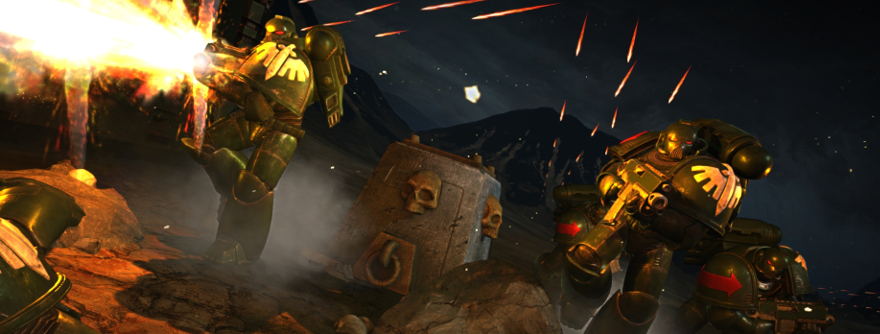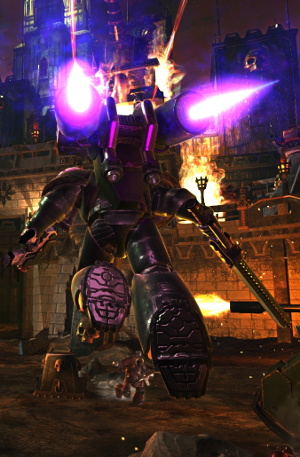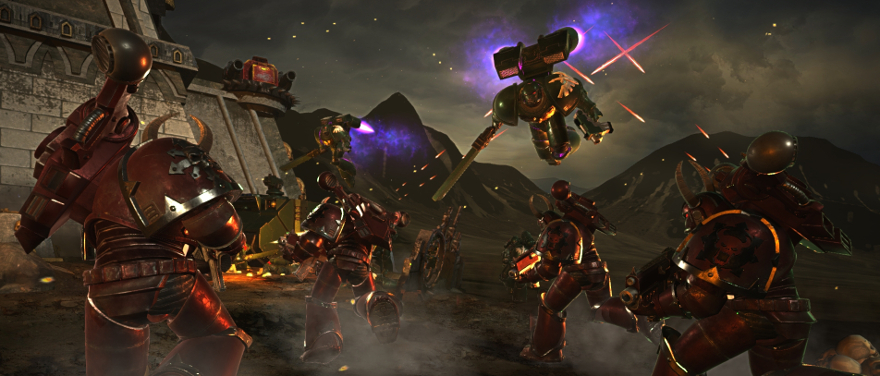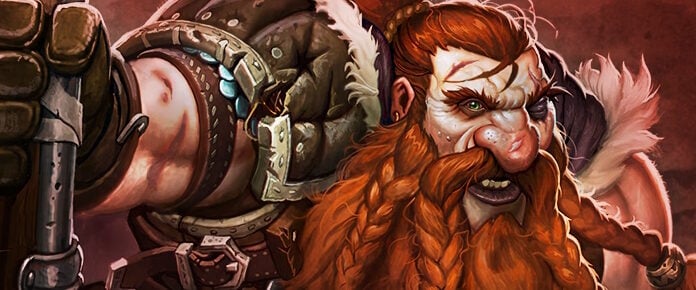
In the grim darkness of the future, there is only war. That may be unfortunate for the inhabitants of the planet Arkhona and the rest of the Warhammer 40,000 universe, but you have to admit that it makes great material for game developers to capitalize on. The latest effort of adapting the world of WH40K into gaming gold comes in the form of Behaviour Interactive’s Warhammer 40,000: Eternal Crusade. Although it’s but one in a long line of WH40K video games, Eternal Crusade is the first (uncancelled) title to attempt to bring this line of the franchise to life in MMO form.
The development of this ambitious MMO shooter has been somewhat tumultuous: 2015 saw the departure of the game’s lead level designer, lead programmer, and creative director from Behaviour Interactive, all in addition to the announcement that the studio had decided to reduce the game’s scope, pushing back the implementation of the game’s open-world elements.
In spite of these setbacks, however, Eternal Crusade became available through Steam’s Early Access program in January 2016, and just last week the game dropped the Early Access tag and celebrated its official launch. A quick glance at the game’s reviews on Steam, however, indicates that its reception has been less than stellar, but as both a critic and a fan of the WH40K franchise, I felt that I ought to check it out for myself, so here we are, in part one of our impressions (part two is also live now).
Given the game’s not-so-smooth development history and my general wariness toward Early Access games, there were three pressing questions that I needed to answer from the outset: Is it an MMO? Is it finished? And of course, is it fun?
Before we dive into the answers to those questions, however, let’s establish some basic information about the game. Eternal Crusade is a third-person shooter that focuses on large-scale warfare between four different factions: the Space Marines, the Chaos Marines, the Orks, and the Eldar. Each faction is further divided into different “subfactions”: Space Marine chapters, Chaos Marine warbands, Ork clans, and Eldar craftworlds – although the differences between each seem to be purely aesthetic.
Each faction has a number of classes available to it (Space Marines, Chaos Marines, and Orks each have five classes, while Eldar has seven), and although the array of weaponry and equipment to which players have access varies wildly across the factions, all classes can be categorized as one of five categories. These categories, as given on the game’s wiki, are ranged, support, heavy, melee, and jump, and those categorizations should give you a good idea of which archetype each class fills within its faction’s unique army.
Ranged classes, of course, specialize in ranged damage; support classes provide valuable healing and support (natch); heavy classes are heavily armored and capable of withstanding large amounts of damage; melee classes prefer to go toe-to-toe with their enemies; and jump classes all have some method of aerial transportation, allowing them to strike swiftly from the sky.
However, while every faction has one class of each category – except the Eldar, which have two ranged and two melee classes – this does not necessarily mean that all classes in a given category are exact mirrors of one another. There’s some overlap, of course, but for the most part, each class is in some way unique from the other classes of its category.
In the interest of full disclosure, though, almost all of my playtime for this column was spent on a single Eldar character, and for that matter, on a single class: the Dire Avenger, one of the Eldar’s two ranged classes. As such, it’s hard for me to provide much insight on whether or not each faction feels especially distinct from the others, at least in mechanical terms.
And on that note, although I’m generally not the best at the theorycrafting and arithmetic behind gauging how well balanced the factions are, my purely anecdotal and possibly unconsciously biased observation is that Eldar, with their high movement speed (in conjunction with some of the game’s technical issues, which I’ll get to soon enough), are at a fairly significant advantage, and Orks seemed to get effortlessly steamrolled in every game I played against them.
At any rate, that’s enough background info for now. Now then, about those questions I asked earlier – let’s start with the first one.

Is Eternal Crusade an MMO?
As it stands, the answer to this one is a pretty solid “no.” This was probably to be expected, especially considering the aforementioned announcement of the pushing back of the game’s open world, but I thought that perhaps there would still be some semblance of MMO-esque mechanics in place, some harbinger of things to come, but sadly that isn’t the case. The game consists entirely of individual game matches (think Battlefield) that pit members of two of the game’s four factions against one another.
Battles come in two flavors: Skirmishes and Grand Battles. Skirmishes are the smaller of the two, pitting between 30 and 40 players against one another, and Grand Battles are only slightly larger, hosting 50 to 60 players per game. So not only is the game not an MMO insofar as it has no kind of persistent open world, the maximum number of players in its largest gametype still falls four players short of the maximum of 64 players in Battlefield and other similar games.
Eternal Crusade does, however, try to provide some sense of a persistent world in the form of the world map, which is exactly what it sounds like: a map of the world with each region color-coded to designate which faction currently controls it. The problem, however, is that it has absolutely zero impact on the game as a whole; unless I’ve missed something crucial, there is absolutely no benefit conferred upon a faction for controlling more territory than the others. In fact, as far as I can tell, it simply serves as a statistics-tracking device that measures which faction has won the most matches on the game map that corresponds to each region of the world map.
It does, however, feature a couple of minor, arguably MMO-esque features. For starters, there is a character progression system in the form of an upgrade tree that allows you to spend advancement points (AP) earned by leveling up (which in turn is done by simply earning points by killing enemies and completing objectives in individual games) to unlock stat upgrades and new equipment.
In my experience, however, the upgrades that you unlock are, at least in the early stages of progression, underwhelming to the point of seeming at times to be wholly insignificant. Most of the upgrades I was able to purchase were only minor benefits, like small buffs to my health or armor, and didn’t seem to have a noticeable effect on my character’s efficacy in battle, so earning enough AP to unlock a new upgrade never felt all that exciting.  I know they can’t just give us all the goodies right off the bat, but having at least a few major unlocks – like new weapons, weapon modifications, or armor – earlier in the progression tree would do a lot to provide a sense of significant progression and thereby provide players with more incentive to keep playing and unlocking more goodies.
I know they can’t just give us all the goodies right off the bat, but having at least a few major unlocks – like new weapons, weapon modifications, or armor – earlier in the progression tree would do a lot to provide a sense of significant progression and thereby provide players with more incentive to keep playing and unlocking more goodies.
It’s also worth mentioning that the premade loadouts to which players have access from the start of the game come equipped with a bunch of gear that is for some bizarre reason not available for use in custom loadouts, meaning that progression feels downright meaningless until you’ve managed to unlock enough upgrades to surpass those granted by the default preset loadouts.
There are also guilds, which just serve as groups to provide players with a group with whom they can play and socialize. I didn’t join one myself, but as I understand it, the functionality is currently pretty barebones, and aside from their aforementioned roles as centers of socialization, they provide no mechanical benefits or advantages.
Lastly, Eternal Crusade also features a sort of PvE in the form of the Lair gametype, which pits five players against a hive full of AI-controlled Tyranids. I played this gametype only a few times throughout my time with the game, and frankly I wasn’t impressed. In Lair battles, players must work together to fight their way through the bowels of a Tyranid hive, fending off swarms of angry Tyranids and completing various objectives along the way.
The objectives come in three varieties: purge, defend, and deliver. Purge objectives are simple: kill everything and don’t die. The other two objective types are exactly what their names say they are: Defend objectives task players with defending a control point from waves of Tyranids until the point is captured, while deliver objectives require the team to transport a piece of cargo to a designated location.
The primary problem I have with the Lair mode is that the Tyranid AI is frankly just not very good. Although the six different types of Tyranid units provide a reasonable amount of variety, they don’t seem to interact with one another to employ even basic tactics, and most of them are melee combatants who resort to simply rushing the players and hoping for the best. As such, they don’t exactly pose an intimidating threat to any decently coordinated group of players.
Or at least they wouldn’t if it weren’t for the units that the folks I played with called “warriors” (I’m not sure what their actual in-universe name is; help me out, 40K nerds) which are because of either a bug or shoddy balancing (I’ve heard both in equal measure) borderline unkillable, especially for a ragtag group of randoms. Their presence can quickly turn an otherwise smooth and well-coordinated Lair assault into an utter debacle, not because their AI is especially clever or their attacks particularly devious but because they’re big ol’ bullet sponges. No one likes a bullet sponge.
In my defense, I’m clearly not alone in my dislike for the Lair mode; the gametype’s outlandishly long queue times seem to indicate that only a minuscule portion of the population actually plays it.

Is Eternal Crusade finished and fun?
For the answer to those questions, catch up with the second part of this article, which is now live as of Wednesday.















